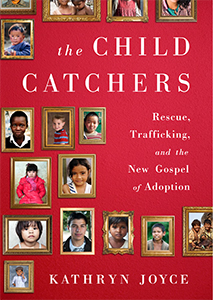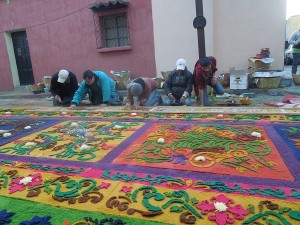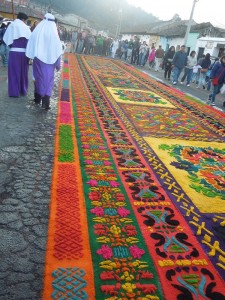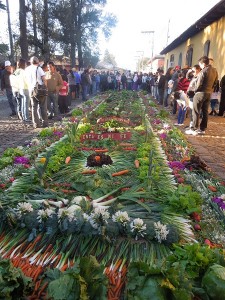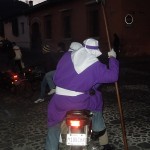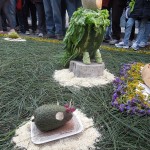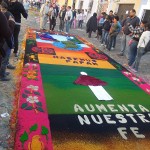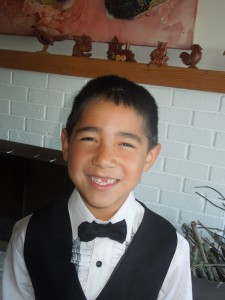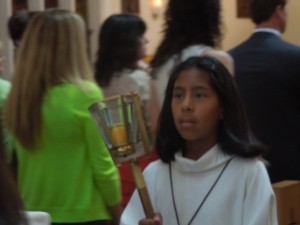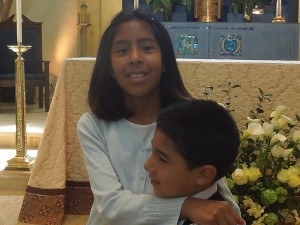Guatemalan court annuls Rios Montt conviction
May 21st, 2013In Australia
May 19th, 2013I’m in Australia with Tim, where it’s now tomorrow. My internal clock has been off since we arrived, sometime last week, although I’m not exactly sure when because somewhere in there we lost a full day, which we should recover on our return journey. Tim was invited to lecture by an association of Australian-Asian physicians, and lucky me, I get to tag along.
We spent the first few days in the North, in the seaside town of Port Douglas, near Cairns, and because we’re in the Southern Hemisphere, north means the tropics. Think palm trees hot, and this is their winter. The highlight of that experience was snorkeling along the Great Barrier Reef: an entire universe under water, thousands of colorful fish, and coral reefs as tall and broad as a high rise. I didn’t even try to take pictures because I knew I just couldn’t capture it.
Now we’re in Sydney, not Australia’s capital, by the way (that’s Canberra), and not nearly as hot as Port Douglas, but also beautiful, with wide boulevards, architecturally distinguished buildings, and many open green spaces and public parks. Today while Tim attended meetings, I took a backstage tour of the Sydney Opera House, saw a Jeff Wall exhibition at the Museum of Contemporary Art, heard an organ recital at St. Mary’s Cathedral, and walked through the Royal Botanic Gardens. Yesterday we looked at the collections of Australian and aboriginal art at the Gallery of New South Wales and explored sections of town named The Rocks and The Circular Quay. Next on my list is a ferry ride to Manly, for optimal Opera House viewing.
Now it’s time to get myself ready for our evening activity, a lovely gathering with Tim’s colleagues.
But before I sign off, I want to express my gratitude to my sisters, Deanna and Patrice, who are taking great care of our kids, the only reason this trip is possible. Thank you, thank you. xoxo
Rios Montt
May 14th, 2013At 86, Rios Montt may be too old and too ill to spend a day in prison. But that doesn’t change the fact that a Guatemala judge found him guilty of genocide committed against the Ixil Maya.
A report by Sonia Diaz Perez of the Associated Press.
PBS NewsHour on Rios Montt trial
May 9th, 2013The PBS News Hour has produced a very powerful news clip about the Rios Montt trial. In case you, like me, don’t ever watch TV, or missed the broadcast for some other reason, here’s the link:
Guatemala: Why We Cannot Turn Away.
That title says it all, don’t you think?
Claudia Paz y Paz to speak at UC Berkeley
May 6th, 2013Claudia Paz y Paz, Guatemala’s Attorney General who brought Rios Montt to trial, will speak at UC Berkeley on Wednesday, May 15 at 10:30 AM in Barrows Hall. Admission is free.
From the UC Berkeley website:
Claudia Paz y Paz Justice and Rule of Law: Keys for Democracy in Guatemala
As Guatemala’s first female attorney general, Claudia Paz Y Paz has made unprecedented strides in the prosecution of organized crime, political corruption, and human rights. In addition to securing convictions against the four Guatemalan soldiers found responsible for the 1982 Dos Erres massacre, she successfully brought Ríos Montt, the former president who presided over Guatemala’s scorched earth campaign, to trial. Paz y Paz was recently honored by U.S. Secretary of State Hillary Clinton and will receive the 2013 Judith Lee Stronach Human Rights Award from The Center for Justice and Accountability on May 14, 2013 in San Francisco.
Commentator: Richard M. Buxbaum is the Jackson H. Ralston Professor of International Law (Emeritus) at UC Berkeley.
Wednesday, May 15, 10:30 am 554 Barrows Hall
“The Child Catchers” by Kathryn Joyce
May 2nd, 2013I recently read Kathryn Joyce’s The Child Catchers: Rescue, Trafficking, and the New Gospel of Adoption. The book’s premise can be summarized by this excerpt from the description on Kathryn Joyce’s website:
To tens of millions of evangelicals, adoption has become a new front in the culture wars: a test of “pro-life” bonafides, a way to reinvent compassionate conservatism on the global stage, and a means to fulfill the “Great Commission” mandate that Christians evangelize the nations. Influential leaders fervently promote a new “orphan theology,” urging followers to adopt en masse, with little thought for the families these “orphans” may actually have. Christian adoption activists have added moral weight to a multi-billion dollar adoption industry intent on increasing the “supply” of adoptable children, both at home and overseas.
The Child Catchers is a shocking exposé of what the adoption industry has become and how it got there, told through deep investigative reporting and the heartbreaking stories of individuals who found that their own, and their children’s, well-being was ultimately irrelevant in a market driven by profit and now, pulpit command.
There’s a lot to say about The Child Catchers, but my overriding reaction is intense frustration that so little has been learned and implemented following Guatemala’s shutdown. Many of the cases cited by Kathryn Joyce take place in Ethiopia and involve corrupt facilitators in-country, who coerce and trick before the final faked paperwork ever makes it as far as the US Embassy. As you probably know if you’re reading this, Ethiopia replaced Guatemala as the adoption “hot spot,” and adoption numbers there sky rocketed after Guatemala closed.
Will nothing ever change?
My second reaction is more of a question: Why should anyone’s religious beliefs enter into the debate over corruption in international adoption? Adoption practices either are corrupt, or they’re not. If they are, shut them down. Or better, don’t allow them to start, which is the intention of the Hague Treaty.
If adoption practices are not corrupt, then it really shouldn’t be anyone’s business why someone chooses to adopt, or what religion they embrace. Religious freedom is one of the hallmarks of the US. Honestly, I’m curious to know what Kathryn Joyce hopes to accomplish by criticizing evangelical Christians for their beliefs and practices. Because my guess is that such criticism in fact may produce the opposite effect of what she intended. Instead of reform, it may (understandably) cause (some) evangelical Christians to feel attacked, leading to a posture of defense.
As I noted above, the book’s description states “[t]o tens of millions of evangelicals, adoption has become the new front in the culture wars,” implying that tens of millions of evangelicals are adopting children internationally through nefarious means. This simply isn’t true. The number of intercountry adoptions to the United States in 2012 in total was fewer than 9,000. If the “tens of millions” refers to evangelicals who are concerned about children in need, then wonderful. Otherwise, the figure seems exaggerated and misleading.
Overall, Joyce’s book is thoroughly researched and well-written, albeit to me as an adoptive mother, unfairly one-sided. Adoption for my husband and me, and every other adoptive parent I know (and that’s a lot of people), is about creating a family. That said, I respect Joyce’s point of view and her right to tell the story she feels compelled to report.
One quibble, though, with The Child Catchers, in general: Joyce devotes much ink to the case of “self-declared missionary” Laura Silsby, who illegally removed children from Haiti after the earthquake, even while admitting Silsby was an outlier who chose not to follow the rules. This was true of several “players” Joyce profiled, who seem extreme in every way, not only regarding adoption.
Also: I was sorry and confused to read that some US birth mothers affected by the 50s “Baby Scoop,” now feel that parents who opt for open adoption are doing so only as a way to ingratiate themselves to birth mothers, and perhaps convince them to relinquish their babies. As many of you reading this know, our family chose open adoption with our kids because we believe it’s healthiest—mentally, psychologically, spiritually, and just the right thing to do—for everyone involved. I’m very sad to learn that some birth mothers may feel we have an ulterior motive or immoral agenda.
Here are links to interviews and articles for more information. The first is a cogent rebuttal by adoptive parent and Senior Counsel at the Center for American Law and Justice, David French. The remainder feature Kathryn Joyce and The Child Catchers:
From the National Review Online: Is the Left Launching an Attack on Evangelical Adoption? by David French.
An interview with Kathryn Joyce on NPR’s Fresh Air: How Evangelical Christians Are Preaching the New Gospel of Adoption.
Kathryn Joyce’s 2011 article in The Nation: The Evangelical Adoption Crusade.
Kathryn Joyce’s 2011 article in The Atlantic: How Ethiopia’s Adoption Industry Dupes Families and Bullies Activists.
An book excerpt in the May 2013 Mother Jones: Orphan Fever.
Finally, a link to an MSNBC interview conducted by Melissa Harris-Perry with Tarikuwa Lemma, a young woman featured in the book who was adopted from Ethiopia at 13 and is now an adult. Scroll around the site to find the interview with Kathryn Joyce and Karen Moline, board member from PEAR (People for Ethical Adoption Reform). I especially liked what PEAR board member Karen Moline said, as an adoptive mother to a son from Vietnam, circa 2001 I believe. Something like “American parents are so trusting that they never, ever believe that bad people motivated by greed could be involved in adoption.” Yes, that would be my husband and me, in the beginning of our process, before we knew anything.
On that note. Still praying for the families of the Guatemala 900, waiting, at a minimum, for more than five years. ~
Semana Santa 2013. Carpets, Rugs, Alfombras
April 26th, 2013 Finally, I’m posting photos of just a few of the amazing alfombras Olivia and I saw during our trip to Antigua over Semana Santa. In Guatemala, unlike in the US, Good Friday is the day considered most significant, which is why a friend of mine, a Catholic nun who lives in-country, describes Guatemalans as “Good Friday Catholics” versus Catholics in the US, whom she labels “Easter Catholics.” Having now participated in my first Semana Santa, I understand what she means.
Finally, I’m posting photos of just a few of the amazing alfombras Olivia and I saw during our trip to Antigua over Semana Santa. In Guatemala, unlike in the US, Good Friday is the day considered most significant, which is why a friend of mine, a Catholic nun who lives in-country, describes Guatemalans as “Good Friday Catholics” versus Catholics in the US, whom she labels “Easter Catholics.” Having now participated in my first Semana Santa, I understand what she means.
Driving to Antigua from the airport, our cab driver had told us that the most spectacular carpets of all of Semana Santa could be seen on a street on Antigua’s north end called Calle Ancha. Teams of artists would have started construction around midnight on Holy Thursday; the earlier we arrived on Good Friday morning, he said, the better. Five AM was the hour he recommended, because that day’s procession started from the church known as La Merced around then, and would arrive at Calle Ancha by 7. As I explained in an earlier blog post, an essential element of constructing the carpets—for the artist and viewer—is watching them destroyed by the feet of the hundreds of pilgrims walking over them as they carry the procession platforms. To see the work intact, we needed to get there early.
Another adoptive mom, Rebecca, and I, slipped out of our hotel and were headed north by 5:30. After a few false turns and a run back to my room for my camera, which in my pre-coffee haze I had forgotten, Rebecca and I found Calle Ancha. Spectacular. Unforgettable. Worth every effort.
What I hadn’t expected, although I should have, was the tone of the day, and every day during Semana Santa, really. “Reverent, solemn, prayerful” are the most accurate descriptors. “Artistic, creative, witty” are a close second. The processions themselves will require a separate post—in their own way, they were as gorgeous and impressive as the carpets.
Semana Santa stands out as one of the best experiences we’ve ever had in Guatemala. We’d love to return to see it again.
I hope you get there, too. Just be sure to make your reservations early! ~
Mateo’s First Holy Communion
April 23rd, 2013This past weekend, following a year of preparation and study at religious education classes taught by a dedicated cohort of volunteer catechists after the regular Sunday Mass at our parish, Mateo received his First Holy Communion. My husband Tim and I, Mateo’s godparents Deanna and David, and the rest of our extended family are so proud of Mateo! We’re proud of Olivia, too, for assisting the priest during the ceremony as one of the Mass’s three altar servers. In my day, girls weren’t permitted to serve at the altar (hence the phrase “altar boy”), so as a Catholic female I’m especially thrilled to witness Olivia’s participation.
(I’m just hoping I live long enough to see the day when women can be ordained as Catholic priests, but that’s another subject.)
Last month, I wrote a blog post about our search for Mateo’s Communion suit, which we purchased in Antigua, Guatemala. Of course I’m biased, but I think my son cuts a dashing and handsome figure in his new threads.
We’re very grateful to our parish priests, to the head of our church’s religious education program, and to all the volunteers who helped shepherd Mateo in his journey to receive this beautiful and ancient sacrament.
Congratulations, Mateo!
Connecticut couple charged with baby smuggling from Guatemala
April 19th, 2013A Connecticut couple, Maria Gonzalez (an Argentinian citizen and legal permanent resident of the US) and Frederick Gonzalez Lopez (a native Guatemalan and naturalized US citizen), have been charged with smuggling a Guatemalan baby into the United States in 2009, using an illegal passport, according to an article by Stephen Kalin published by the Associated Press. As you know, international adoptions between the US and Guatemala closed in December 2007, and thus no adoption took place.
This case reminds me very much of a similar episode that happened to a friend of mine in California. Some years ago, “Sally” and her husband wished to adopt a baby, and an acquaintance of theirs, a Guatemalan national living in California, who possessed a passport that allowed him to cross international borders, said he knew of a baby “available” in Guatemala. For a large fee, the man offered to falsify a Guatemalan birth certificate, bring the baby into the US, and arrange a private adoption here. Sally declined the offer, and ultimately formed her family in another way. Until Sally told me her story, I never considered this possibility, but upon reflection, and acknowledging the ease with which some documents in Guatemala may be falsified, I realize this may be easier than it may first appear.
This week, another friend living in Guatemala said that the Connecticut case is being reported widely there—and rightfully so. Nobody wants to see the law of their land circumvented, particularly when the law involves a baby illegally being taken across international borders. One of the many tragedies here is that the fall-out from this case may affect the approximately 100 families of the Guatemala 900 who have been trying to finish their cases legally since the adoption shutdown. I hope not.
Please read the entire AP article to get all the facts. Here’s an excerpt:
HARTFORD, Conn. (AP) — A Connecticut couple has been charged with smuggling an infant from Guatemala into the United States.
A federal complaint released Thursday says 42-year old Maria Gonzalez of Stamford and her husband, 36-year-old Henry Fernandez Lopez of Fairfield, brought the infant into the country after making an agreement with the child’s mother who was 14 years old at the time.
The couple is charged with illegally bringing an immigrant into the U.S. and harboring the child, as well as conspiracy to commit those acts.
Gonzalez also is charged with misuse of a U.S. passport and forgery or false use of a passport.
The case may represent the desperate measures that prospective parents are willing to take to adopt children from Guatemala since that country shut down its international adoption program more than five years ago. The country’s quick-stop adoptions had made the nation of 14 million people the world’s second-largest source of babies to the U.S. after China.
But the vibrant business came to a halt after an August 2007 raid on what was considered the country’s most reputable adoption agency, used by many Americans. Guatemala remains closed to inter-country adoption, according to the National Council for Adoption.
Gonzalez revealed to Homeland Security officials in 2012 that she was connected to a pregnant teenager in Guatemala through a former coworker’s mother living there. She said she traveled to Guatemala in March 2009 and met the teenager, accompanied her to a doctor’s visit and arranged to take custody of the child at birth in exchange for paying for the delivery and additional unspecified costs.
The teenager was interviewed by US officials in Guatemala who described her neighborhood as ‘‘poverty-stricken and a high crime area.’’ She revealed that the infant she had given to Gonzalez and Lopez was the result of a rape by a family member. She also confirmed that she had agreed to give her child to Gonzalez but said she had never signed any adoption papers.
Gonzalez said that the doctor in Guatemala had informed her that an adoption could not take place because the birth mother was an orphan and did not have a birth certificate.
[Note from me: Of course no adoption could take place because adoptions were shut down. How could the Connecticut couple not know this?]
After the infant was born, Gonzalez attempted to acquire travel documents for the child from the US embassy in Guatemala City but was refused when she could not prove she was the birth mother. The complaint claims that she then paid a Guatemalan man $6,000 for a fraudulent US passport for the child.
Travel records show that Gonzalez crossed into California with the infant in July 2009 by using the forged passport.
Happy.
April 18th, 2013Today is one of those days when I woke up happy, possibly because for the first time in ages I slept through the night. This happens so rarely I can’t remember the last time it actually did. Even as I write this, I’m thinking, “Oh, this is what it feels like to be rested!” A novel concept.
You would think that I’d be getting all kinds of delayed-maintenance projects completed, given that I’m feeling maximally energized. Not exactly. But this morning I did volunteer for a few hours at Olivia’s school, in the art classroom, and, once again, observing Olivia up close confirmed for me “Yep. No doubt about it. My daughter’s an artist.”
A while back a friend who paints defined the word this way: “An artist is someone who works until it’s finished.”
What a perfect summary, don’t you think? And of course “artist” can apply to many fields, not only painting and drawing. Writing, too.
Fourth grade—Olivia’s level—stands out vividly for me because that was the year my family moved from Long Island, New York, to the Jersey shore. I began keeping a journal in fourth grade, which I still have, and wrote my first short story, about two girls the exact same ages as my then-best friend and me. Fourth grade was when I began to feel like the person I finally became.
Watching Olivia focus intently on her work—today, aboriginal dot paintings—multiplied my already existing happiness.
Often when my kids are whining about whatever thing is bugging them at that moment I say to them, “Happiness is a choice.”
Which is a philosophy I believe. And that I need to remember on days when I’m not feeling so rested. ~



 ShareThis
ShareThis


